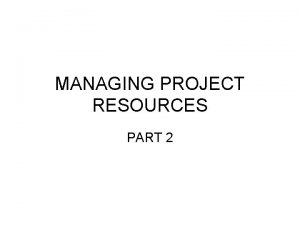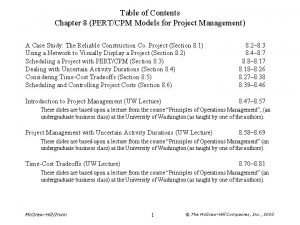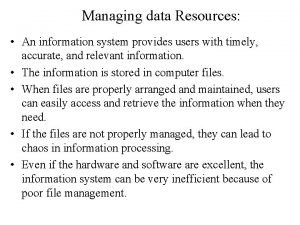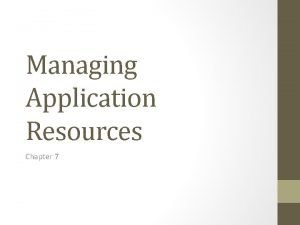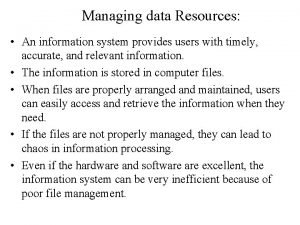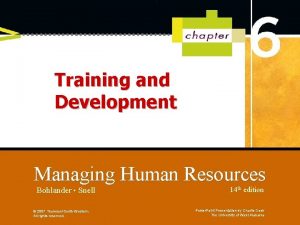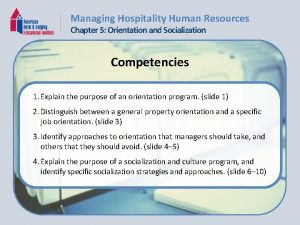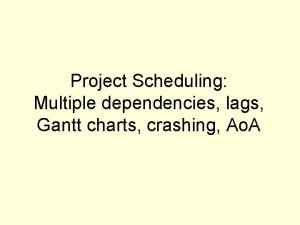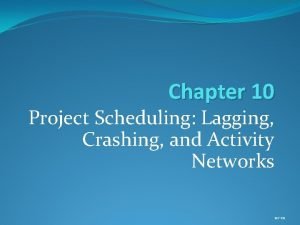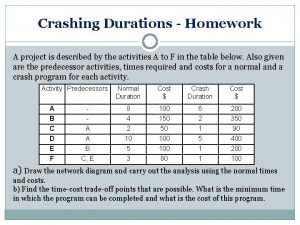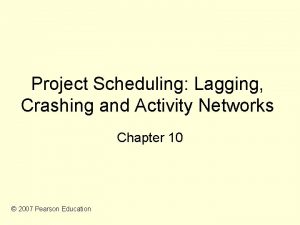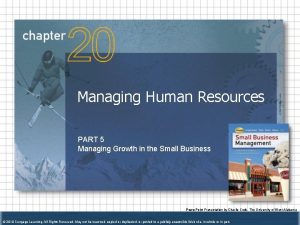MANAGING PROJECT RESOURCES PART 2 Project Crashing The























- Slides: 23

MANAGING PROJECT RESOURCES PART 2

Project Crashing ØThe process of accelerating a project is referred as crashing. ØCrashing a project relates to resource commitment; the more resources expended, the faster the project will finish. ØThere are several reasons to crash a project: q. Initial schedule was too optimistic q. Market needs change and the project is in demand earlier than anticipated q. The project has slipped considerably behind schedule q. There are contractual late penalties

Project Crashing ØPrincipal methods for crashing q. Improving existing resources’ productivity q. Changing work methods q. Increasing the quantity of resources ØIncreasing the quantity of resources is the most commonly used method for project crashing. There are 2 approaches: q. Working current resources for longer hours (overtime, weekend work) q. Adding more personnel

Project Crashing Fully expedited (no expense is spared) Time-Cost Trade-Offs for Crashing Activities

Project Crashing ØIn analyzing crash options, the goal is to find the point at which time and cost trade-offs are optimized. ØVarious combinations of time-cost trade-offs for crash options can be determined by using the following formula: Slope = crash cost – normal cost normal time – crash time

Example SUPPOSE: NORMAL ACTIVITY DURATION = 8 WEEKS NORMAL COST = $14, 000 CRASHED ACTIVITY DURATION = 5 WEEKS CRASHED COST = $23, 000 THE ACTIVITY COST SLOPE = 23, 000 – 14, 000 OR $9, 000 = $3, 000 per week 8– 5 3 Cease crashing when the target completion time is reached the crash cost exceeds the penalty cost

Example Normal Activity Duration Cost A 4 days $1, 000 B 5 days $2, 500 C 3 days $750 D 7 days $3, 500 E 2 days $500 F 5 days $2, 000 G 9 days $4, 500 Crashed Duration Cost 3 days $2, 000 3 days $5, 000 2 days $1, 200 5 days $5, 000 1 day $2, 000 4 days $3, 000 7 days $6, 300 a) Calculate the per day costs for crashing each activity b) Which are the most attractive candidates for crashing? Why?

Example Activity A B C D E F G Per Day Cost $1, 000 $1, 250 $450 $750 $1, 500 $1, 000 $900

Resource Allocation Problem ØA shortcoming of most scheduling procedures is that they do not address the issues of resource utilization and availability. ØScheduling procedures tend to focus on time rather than physical resources.

Resource Allocation Problem ØSchedules should be evaluated not merely in terms of meeting project milestones, but also in terms of the timing and use of scarce resources. ØA fundamental measure of the project manager’s success in project management is the skill with which the trade-offs among performance, time, and cost are managed. Ø“I can shorten this project by 1 day at a cost of $400. Should I do it? ”

Resource Allocation Problem The extreme points of the relationship between time use and resource use are the following: ØTime Limited: The project must be finished by a certain time, using as few resources as possible. But it is time, not resource usage, that is critical ØResource Limited: The project must be finished as soon as possible, but without exceeding some specific level of resource usage or some general resource constraint

Resource Loading ØResource loading describes the amounts of individual resources an existing schedule requires during specific time periods ØThe loads (requirements) of each resource type are listed as a function of time period ØResource loading gives a general understanding of the demands a project or set of projects will make on a firm’s resources

Resource Loading ØThe project manager must be aware of the ebbs and flows of usage for each input resource throughout the life of the project. ØIt is the project manager’s responsibility to ensure that the required resources, in the required amounts, are available when and where they are needed.

Resource Loading Table

Resource Leveling (Smooting) ØResource leveling aims to minimize the period -by-period variations in resource loading by shifting tasks within their slack allowances. ØThe purpose is to create a smoother distribution of resource usage. ØResource leveling, referred to as resource smoothing, has two objectives: ØTo determine the resource requirements so that they will be available at the right time, ØTo allow each activity to be scheduled with the smoothest possible transition across usage levels

Resource Leveling (Smooting) ØResource management is a multivariate, combinatorial problem, i. e. multiple solutions with many variables, the mathematically optimal solution may be difficult or infeasible. ØMore common approach to analyzing resource leveling problems is to apply some resource leveling heuristics.

Resource Leveling Heuristics ØPrioritizing resource allocation include applying resources to activities: qwith the smallest amount of slack qwith the smallest duration qthat start earliest qwith the most successor tasks qrequiring the most resources

Resource Leveling Steps ØCreate a project activity network diagram ØCreate a table showing the resources required for each activity, durations, and the total float available ØDevelop a time-phased resource loading table ØIdentify any resource conflicts and begin to smooth the loading table using one or more heuristics

Resource Loading Chart Display the amount of resources required as a function of time. 4 B 5 Res = 2 0 A 4 Res = 6 5 D 9 Res = 7 9 E 11 Res = 3 1. Start with a network diagram 4 C 7 Res = 2 11 F 12 Res = 6

Resource Loading Charts Activity A B C D E F Resource 6 2 2 7 3 6 Duration ES Slack LF 4 1 3 4 2 1 0 4 4 5 9 11 0 0 4 0 0 0 4 5 11 9 11 12 2. Produce a table that shows the duration, early start, late finish, slack, and resource(s) required for each activity.

Resource Loading Charts 3. Draw an initial loading chart with each activity scheduled at its ES. Resources 8 6 4 A D B 2 C 2 4 F E 6 8 10 12 Project Days 14 Resource imbalance

Resource Loading Charts 4. Rearrange activities within their slack to create a more level profile. Splitting C creates a more level project. Resources 8 6 4 A B 2 C 2 4 D C F E 6 8 10 12 Project Days 14

Resource Loading Chart
 Project crashing example
Project crashing example Crashing in project management example
Crashing in project management example What is a resource loading chart
What is a resource loading chart Project crashing
Project crashing Reliable construction company
Reliable construction company Contoh soal crashing manajemen proyek
Contoh soal crashing manajemen proyek Managing human resources in small and entrepreneurial firms
Managing human resources in small and entrepreneurial firms Managing data resources
Managing data resources Resources application
Resources application Managing human resources in small and entrepreneurial firms
Managing human resources in small and entrepreneurial firms Managing global human resources
Managing global human resources Importances of hrm
Importances of hrm Managing human resources bohlander
Managing human resources bohlander Managing data resources
Managing data resources Information technology resource
Information technology resource Chapter 10 managing human resources
Chapter 10 managing human resources Managing human resources bohlander
Managing human resources bohlander Managing human resources in small and entrepreneurial firms
Managing human resources in small and entrepreneurial firms Managing hospitality human resources
Managing hospitality human resources Managing global human resources
Managing global human resources Transforming and transformed resources
Transforming and transformed resources Variable resources definition
Variable resources definition Renewable resources vs nonrenewable resources
Renewable resources vs nonrenewable resources Managing your weight part 2
Managing your weight part 2


